JPercival G. Lowe
Class of 1883
18th Infantry, Seminole Negro-Indian Scouts
Siler Lifesaving Medal for heroism in rescuing a Seminole Negro-Indian scout from drowning in the Pecos River, near Eagle Nest, Texas.
JPercival G. Lowe
Class of 1883
18th Infantry, Seminole Negro-Indian Scouts
Siler Lifesaving Medal for heroism in rescuing a Seminole Negro-Indian scout from drowning in the Pecos River, near Eagle Nest, Texas.
 Percival G. Lowe was born in 1863 in Leavenworth, Kansas. He completed his education in the local schools and entered PMC in 1880. He graduated from PMC in 1883 as an honor student, “First Captain” of the Corps of Cadets and received a C.E. (Civil Engineering) degree. Lowe returned to Leavenworth and for the next two years was employed as an assistant city engineer. In 1885 he enlisted in the 18th U.S. Infantry. He was commissioned a Second Lieutenant of Company B in 1889 and graduated from the infantry and cavalry school in 1895.
Percival G. Lowe was born in 1863 in Leavenworth, Kansas. He completed his education in the local schools and entered PMC in 1880. He graduated from PMC in 1883 as an honor student, “First Captain” of the Corps of Cadets and received a C.E. (Civil Engineering) degree. Lowe returned to Leavenworth and for the next two years was employed as an assistant city engineer. In 1885 he enlisted in the 18th U.S. Infantry. He was commissioned a Second Lieutenant of Company B in 1889 and graduated from the infantry and cavalry school in 1895.
He was sent to Fort Bliss, Texas, in 1896 and placed in command of the Seminole-Negro Indian Scouts. Under his leadership, the Scouts had played a pivotal role in ending violations of U.S. neutrality laws by Mexican revolutionaries and bandits in Texas, including the killing of Mangas de Agua, described as the most desperate of all the bandits.
In 1898, Secretary of War Russell Alger ordered three military expeditions to explore Alaska. Captain William R. Abercrombie, U.S. Army, commanded the second expedition. Upon his arrival, Abercrombie divided his party into two groups. The first was to make reconnaissance surveys of the Prince William Sound and the second, led by Lowe, was to navigate and chart the overland trail from Valdez to the Yukon River. Perhaps the most noteworthy event of Lowe’s expedition occurred when Abercrombie named the Lowe River after him, reportedly because of his endurance and scouting abilities.
In the spring of 1899, Lowe was promoted to Captain, given command of L Company in the 25th Infantry. and deployed to the Philippines. Lowe’s reputation as an Indian fighter and navigator was well-known when he arrived in the Philippines. As a result, General Henry W. Lawton assigned Lowe to be his chief of scouts. With the help of his friend from the Abercrombie Exploration of Alaska, Lieutenant Joseph C. Castern, 4th Infantry, Lowe pulled together a core group of enlisted men and Tagalog scouts. Henceforth they were known as “Lowe’s Scouts.“ With the need for more forces to garrison and patrol the territory, the number of Lowe Scouts increased. Within a year, over 100 Ilocano recruits were raised and “Lowe’s Scouts” grew to 250 soldiers. In addition, this unit became an integral part of the growing intelligence network of native spies and informants.
In October1899, a plan developed to deal with Filipino revolutionary positions in the Cabanatuan area . American troops were to make a frontal attack at night, with Lowe’s Scouts, commanded by Lt. Castern, supporting the attack on its right flank. The fight was over by noon without any American casualties and the revolutionaries fleeing in disarray. This was the first real fight that included the scouts. During the battle this small force moved quickly and struck the entrenched revolutionaries hard. More importantly they proved their loyalty to the American forces.
The challenge of managing the scouts in the Philippines took a heavy toll on Lowe’s health and he was sent back to the U.S. By 1903, he had retired from military and was confined to the hospital in Colgate, Oklahoma. He died in 1910 at the age of 47.
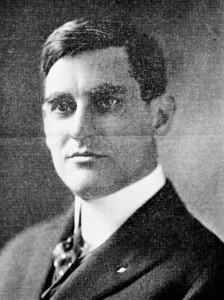 After completing high school in three years, George B. Christian, Jr., left Marion Ohio and enrolled at Pennsylvania Military College. He was a gifted student, earning the title of distinguished Cadet for earning a spot on the Merit List. Colonel Frank Hyatt wrote that “Mr. Christian is a cadet of high character and excellent intellectual attainments.” In 1896, he graduated with a Civil Engineering degree. He then returned to Marion and worked for his father at the Norris & Christian Stone and Lime Company.
After completing high school in three years, George B. Christian, Jr., left Marion Ohio and enrolled at Pennsylvania Military College. He was a gifted student, earning the title of distinguished Cadet for earning a spot on the Merit List. Colonel Frank Hyatt wrote that “Mr. Christian is a cadet of high character and excellent intellectual attainments.” In 1896, he graduated with a Civil Engineering degree. He then returned to Marion and worked for his father at the Norris & Christian Stone and Lime Company.
Christian was also the next-door neighbor of Warren and Florence Harding. At an early age he delivered the Star newspaper, owned and operated by Harding. When Harding ran for the U.S. Senate in 1913, Christian was very involved in the campaign. One of the first decisions Harding made as senator-elect was to hire Christian as his personal secretary. As Harding’s alter ego this association continued throughout Harding’s presidency.
As Secretary to the President, Christian was the precursor of today’s White House Chief of Staff. He would act as the buffer between the President and public, keeping the President’s schedules and appointments, managing his correspondence, communicating to the press and managing the White House staff, which consisted of 31 people during the Harding Presidency.
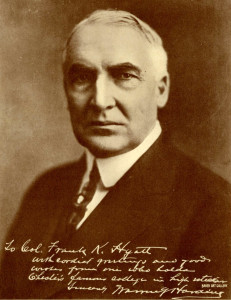 In February, 1920, PMC held its annual recognition of Washington’s birthday. Then Senator Harding, accompanied by Christian, was the featured speaker and was awarded the degree of Doctor of Laws. Harding’s address was described as a “tribute to PMC.” Although Harding declined an invitation to attend the Centennial Commencement Ceremony, Christian sent a photo of the President inscribed with the comment “… from one who holds Chester’s famous college in high esteem.”
In February, 1920, PMC held its annual recognition of Washington’s birthday. Then Senator Harding, accompanied by Christian, was the featured speaker and was awarded the degree of Doctor of Laws. Harding’s address was described as a “tribute to PMC.” Although Harding declined an invitation to attend the Centennial Commencement Ceremony, Christian sent a photo of the President inscribed with the comment “… from one who holds Chester’s famous college in high esteem.”
Christian was devastated after the unexpected death of Harding in 1923. In an interview with the New York Times he commented: “For nearly nine years I worked beside him and my present sorrow is somewhat assuaged by the feeling of satisfaction of having been permitted to serve a great president, a most humane and considerate chief and the finest friend as has ever been given a man to have.” Although he assisted with the transition of President Coolidge, Christian turned down the President’s offer to remain.
For the next few years, Christian devoted his time to working with the Harding Memorial Association, which was formed shortly after Harding’s death to plan and raise money for the Harding Memorial. He had also planned on writing a biography about Harding and his own experiences, but he developed glaucoma, with eventually robbed him of his sight. By 1930 he was inactive and his health began to fail. died in 1951.
 The PMC – Merchant Marine Academy football game was billed as “The Little Army – Navy game,” held each year at the Boardwalk Bowl in Atlantic City, N.J. Stealing the Kings Point Victory Bell was our version of West Point stealing the Navy goat from Annapolis. We inherited the idea from the class of ’63 when Jack Geoghegan, the Cadet 1st Captain, led an expedition of his classmates to try, but failed, with disastrous consequences for him. We heard about that story as Rooks and it stayed with us for the next four years. No class in between attempted the stunt again. The Class of ’63 were great mentors, having many characters who inspired us to become “the best class” at PMC, and so it was only natural that we would one day attempt to get that bell.
The PMC – Merchant Marine Academy football game was billed as “The Little Army – Navy game,” held each year at the Boardwalk Bowl in Atlantic City, N.J. Stealing the Kings Point Victory Bell was our version of West Point stealing the Navy goat from Annapolis. We inherited the idea from the class of ’63 when Jack Geoghegan, the Cadet 1st Captain, led an expedition of his classmates to try, but failed, with disastrous consequences for him. We heard about that story as Rooks and it stayed with us for the next four years. No class in between attempted the stunt again. The Class of ’63 were great mentors, having many characters who inspired us to become “the best class” at PMC, and so it was only natural that we would one day attempt to get that bell.
![]() Early in the Fall of our senior year, Andy Patten took a trip with his parents and sister to visit Kings Point. Posing in civilian clothes as a prospective midshipman, Andy made a reconnaissance of the campus, taking photos of the bell and surrounding location. When he returned to campus, he had a meeting with Glenn Dennis and Bill Symolon to discuss a plan. One of the main points noted was when Jack Geoghegan made his run on Kings Point he took along a large contingent of classmates; something like 15 or 20. We knew that was just too many bodies with too much chance for discovery. We settled on a raid mission with a very small force. Bill’s Marine Corps training told him a fire team of 4 would be the right size force to pull this off. We quickly agreed and then had to pick the team.
Early in the Fall of our senior year, Andy Patten took a trip with his parents and sister to visit Kings Point. Posing in civilian clothes as a prospective midshipman, Andy made a reconnaissance of the campus, taking photos of the bell and surrounding location. When he returned to campus, he had a meeting with Glenn Dennis and Bill Symolon to discuss a plan. One of the main points noted was when Jack Geoghegan made his run on Kings Point he took along a large contingent of classmates; something like 15 or 20. We knew that was just too many bodies with too much chance for discovery. We settled on a raid mission with a very small force. Bill’s Marine Corps training told him a fire team of 4 would be the right size force to pull this off. We quickly agreed and then had to pick the team.
Since Bill was the Cadet 1st Captain of our class, we all knew that he would have to be in this party to take up where Jack had left off. Andy, having made the reconnaissance and given us the basics of the plan, was a solid 2nd member. Glenn Dennis clearly wanted to be in, but, showing the maturity of a good ROTC student who had absorbed the leadership lessons of instructors like Ranger Captain Doug Detlie, realized that the CO and XO of a unit should never be on a mission together. He reluctantly agreed to stay behind. Who would be the other two members? We felt the team had to have the Army Ranger-type personalities, so Mike Stalkus, with his prior Army experience, immediately came to mind. He quickly signed up. Finally, the 4th member came looking for us. Somehow, word of this plan had leaked out even though we tried to keep it close-hold so no one in school administration might stop it before it began. Tom Keller came to us one night and just about begged to be in the Bell Force. With his high enthusiasm, he became number 4. Truth be told, the Class of ’66 was chock-full of cadets who could have easily joined the team.
Next decision point was when to conduct the raid. We chose the night of the Kings Point – Coast Guard Academy game, knowing the campus would be nearly deserted. Camouflaged and armed with the necessary tools to dismantle the bell based on Andy’s detailed recon, our team made it to the objective undetected. The bell was separated from its moorings and man-handled back to the getaway vehicle, which was Andy Patten’s VW bug. It was a near flawless operation with the only misstep being an inadvertent clanging of the bell one time, but not enough to draw attention. On the way back, we were stopped by a police officer for a reason lost to memory. But, thanks to some quick thinking and fast talking by Andy, who was driving, the good cop let us go. And we made it safely back to campus.
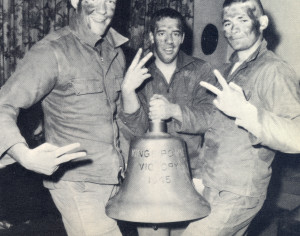 First thing Monday morning, Bill Symolon told Col Menard, our Commandant, about the caper. His reaction was to give a sly smile and say, “Oh Dear…. how will we get it back to them?” Our group already had that plan, which was to happen at half time of our game when we would march out to mid field and deliver it to Kings Point, under the cheers of our admiring classmates. Col Menard’s reaction to that idea was, once again, to say, “Oh Dear, we can’t do that.” So, his judgment prevailed and he arranged with the Commandant of Midshipmen at Kings Point to receive the bell at half time, but quietly behind the stadium…deftly avoiding a potential mini riot on the football field.
First thing Monday morning, Bill Symolon told Col Menard, our Commandant, about the caper. His reaction was to give a sly smile and say, “Oh Dear…. how will we get it back to them?” Our group already had that plan, which was to happen at half time of our game when we would march out to mid field and deliver it to Kings Point, under the cheers of our admiring classmates. Col Menard’s reaction to that idea was, once again, to say, “Oh Dear, we can’t do that.” So, his judgment prevailed and he arranged with the Commandant of Midshipmen at Kings Point to receive the bell at half time, but quietly behind the stadium…deftly avoiding a potential mini riot on the football field.
This escapade could never have succeeded without a grand plan well executed and an equal measure of good luck. The plan grew out of the combined efforts of the classmates involved. The good fortune came from Andy Patten’s quick wit at a crucial point. A third windfall came unexpectedly. Andy’s fiancé’s parents gave us the shelter of their home as a way station for the raid and Andy’s future father-in-law constructed a wooden crate for us in which to carry the bell to its destination in Atlantic City.
And this story is just one reason why the Class of ’66 remains the Best Class ever at PMC.
Written by Bill Symolon, Andy Patten, Mike Stalkus and Tom Keller
Cann Memorial Hall was dedicated in February, 1965. At the time, Cann housed 86 Rooks (freshmen Cadets) and a small cadre of upperclassmen. The dormitory was named in honor of George Turner Cann, PMC 1885. The dedication ceremony was attended by faculty, Cadets and honored guests of PMC, including Cadet Captain Walter Clayton Jr., President of the Board of Trustees, Laurence Sharples, and Cann family members. In accepting the dormitory, it was said Cann “certainly was not ordinary.”
Judge Cann’s forebears settled in Georgia shortly after James Oglethorpe founded the colony in 1732. He was the valedictorian of his high school class in 1882 and entered Pennsylvania Military Academy in the fall. After only three years, he earned the distinction of being Cadet Captain, achieved the highest grade average (99.7 on the Merit List) ever attained at PMA, and became the class valedictorian. After graduation he attended Columbia University where he continued his studies and received his diploma from the law school. He returned to Savannah and was admitted to the bar. His law career included three terms as county attorney and as judge of the Eastern Judicial Circuit Court of Georgia.
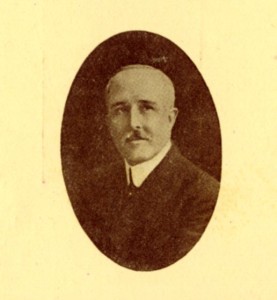 George Cann was an active participant in many civic and fraternal organizations, including the Savannah Board of Trade, the Georgia Historical Society, and Director of the YMCA. In 1887, he joined the Savannah Volunteer Guards as a private. He advanced quickly, however, and attained the rank of captain of Company C. He was a skilled marksman and led Company C at the sixth annual New Jersey Riflemen tournament at Sea Girt, NJ. In 1896. Cann won the Wimbledon Cup with a score of 103 of of a possible 150.
George Cann was an active participant in many civic and fraternal organizations, including the Savannah Board of Trade, the Georgia Historical Society, and Director of the YMCA. In 1887, he joined the Savannah Volunteer Guards as a private. He advanced quickly, however, and attained the rank of captain of Company C. He was a skilled marksman and led Company C at the sixth annual New Jersey Riflemen tournament at Sea Girt, NJ. In 1896. Cann won the Wimbledon Cup with a score of 103 of of a possible 150.
In 1924, Judge Cann conferred the degree of Bachelor of Military Science upon 64 PMC alumni. Judge Cann explained that “the degree was designed to honor graduates of PMC who had served in any branch of the military in time of actual warfare.” He went on to say that PMC
creates a sound body and healthy mind, teaches obedience ot law and authority and inspires lofty ideals. PMC men have been heroes in peace and in war. They are always ready to make the supreme sacrifice when their country calls them.
Throughout his life Judge Cann continued his involvement with PMC. He was a member of the Board of Trustees from 1924-1937 and was awarded the Honorary Degrees of Master of Arts in 1892 and Doctor of Laws in 1935.
 Gordon M. Bettles left Montana in 1906 and entered PMC, He quickly became a leader in a very talented class. As a senior, he received the honor of being the Cadet Battalion Commander. Commander Bettles was also an athlete and captained the football team. At Commencement he was awarded a degree in Civil Engineering and continued his education at the Colorado School of Mines. He oversaw the successful mining operations of the Yellow Tiger Mining Company in Goldfield, Nevada and introduced the use of an oil-driven compressor to mine the gold. In 1937, Bettles left his lucrative position at the Wiljobar Corporation in California and sailed to the Philippines. He was to become a part of a mining syndicate in Manila.
Gordon M. Bettles left Montana in 1906 and entered PMC, He quickly became a leader in a very talented class. As a senior, he received the honor of being the Cadet Battalion Commander. Commander Bettles was also an athlete and captained the football team. At Commencement he was awarded a degree in Civil Engineering and continued his education at the Colorado School of Mines. He oversaw the successful mining operations of the Yellow Tiger Mining Company in Goldfield, Nevada and introduced the use of an oil-driven compressor to mine the gold. In 1937, Bettles left his lucrative position at the Wiljobar Corporation in California and sailed to the Philippines. He was to become a part of a mining syndicate in Manila.
The bombings at Pearl Harbor in 1941 suddenly and dramatically changed the American attitude towards the Philippines. Since becoming a colony at the end of the Spanish American War, America’s approach was muddled. To many, the Philippine were an economic investment. This resulted in various large and small companies seeking the wealth of lumber, sugar and precious metals that the islands offered. After Pearl Harbor, the view was that Manila Bay was a large well-fortified port in the Pacific.
Within a month, Gordon Bettles and 6,000 other American and British civilians were interred in Japanese prison camps in Manila. The largest of these camps was Camp No. 1, University of Santo Tomása Internment Camp. The University campus consisted of 50 acres and was surrounded by high masonry walls on three sides an an ornate iron fence facing the main street. Inside the compound were the Main Building and an education building, both structures were 3-stores in height and contained offices, classrooms and a gymnasium. In addition, there were two light construction one-story buildings called the Annex and the Infirmary. Segregated by sex, thirty to fifty people were crowded into these small spaces. Bathrooms were scarce.
While there were many difficulties accommodating the growing number of internees, the Japanese absolved themselves of any responsibility. The Japanese did not consider the internees to be prisoners, but merely civilians held in protective custody. This left the internees struggling to find ways of feeding of themselves and dealing with a variety of health issues.
On June 14, 1943, Gordon M. Bettles, age 50, died of unknown causes while imprisoned. He was buried in the Manila North Cemetery.
Watch a photographic slideshow of the “University of Santo Tomas during the 2nd World War.”
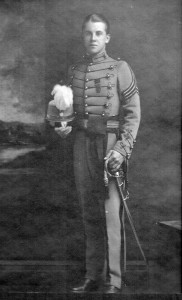 For 150 years, PMC taught students to be academically disciplined and instilled in them the qualities of leadership. Two brothers, Hugh and Joe McCaffery (read more), learned these lessons well and were superior leaders at a time when the nation needed them.
For 150 years, PMC taught students to be academically disciplined and instilled in them the qualities of leadership. Two brothers, Hugh and Joe McCaffery (read more), learned these lessons well and were superior leaders at a time when the nation needed them.
Hugh McCaffrey ‘24 started in the PMC Prep School and then entered the college. During his time at PMC he was a multi-sport athlete, football, basketball and baseball, and was admired by his classmates for his energy and leadership. As the quarterback of the football team, McCaffrey was considered by many, including Col. Frank Hyatt, to be “slightly” better than Reds Pollock ’34. In 1924, he received his Degree in Civil Engineering from PMC and was commissioned as a Second Lieutenant in the Army Reserves. McCaffery then entered law school at Notre Dame University. While there, he joined the swim team, became the team’s captain, set collegiate records in the 100-meter freestyle, and qualified for the Olympics swim team. After earning his law degree, his interest in flying took him in a different direction.
McCaffery was a gifted pilot. Before joining the Army Air Corps in 1930, he graduated from the School of Aviation at Essington, PA. He then joined the Army Air Corps and completed flying school at Randolph Field in Texas. Thereafter, he received specialized training in pursuit, observation and bombardment in a variety of airplanes. Upon completing his training, he was assigned to the 31st Bombardment Squadron. In 1939, he was an instructor at the Air Navigation School at Hickam Field in Hawaii. In 1940, he was put in charge of the squadron.
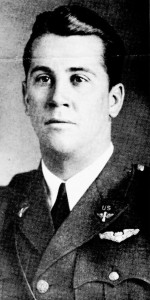 Shortly after the attack on Pearl Harbor, Secretary of War Stimson ordered Major General Herbert A. Dargue, an aviation pioneer and commanding officer of the First Air Force, and his staff, including Major McCaffery, to investigate the lack of preparedness at Pearl Harbor and to take command of the Army units in Hawaii. On December 12, 1941, while flying a Douglas B-18 enroute to Hamilton Field in California, McCaffrey encountered a snow storm as he approached the Sierra Nevada Mountains and subsequently went missing. An exhaustive search was conducted. It wasn’t until May, 1942, that a search party led by Norman Clyde, a well-known mountaineer with experience in the Sierra Nevada, found the aircraft and bodies, covered by five feet of snow.
Shortly after the attack on Pearl Harbor, Secretary of War Stimson ordered Major General Herbert A. Dargue, an aviation pioneer and commanding officer of the First Air Force, and his staff, including Major McCaffery, to investigate the lack of preparedness at Pearl Harbor and to take command of the Army units in Hawaii. On December 12, 1941, while flying a Douglas B-18 enroute to Hamilton Field in California, McCaffrey encountered a snow storm as he approached the Sierra Nevada Mountains and subsequently went missing. An exhaustive search was conducted. It wasn’t until May, 1942, that a search party led by Norman Clyde, a well-known mountaineer with experience in the Sierra Nevada, found the aircraft and bodies, covered by five feet of snow.
On the evening of October 14, 1949, the Corps of Cadets gathered in the Armory to hear Bill Stern, ’30 (read more) noted sports broadcaster. During his 15-minute, coast-to-coast broadcast that evening, Stern paid tribute to Hugh and Joe McCaffery, who had been killed in action. Any death in war is tragic. For PMC, the loss of the McCaffery boys was very personal and underscored the sacrifice PMC has made while serving our country.
Robert R. Stewart
Class of 1968
6th Battalion, 31st Infantry, 9th Infantry Division, USARV
Bronze Star w/Valor for heroism while serving as a platoon leader during a night combat operation against a numerically superior enemy force. 1LT Stewart exposed himself to heavy small arms and automatic weapons fire upon contacting an entrenched enemy force, enabling him to direct the actions of his men and orchestrate the delivery of indirect fire and gunships. The effect of sound maneuver and well placed fires routed the enemy force and inflicted heavy casualties. 1LT Stewart’s actions were instrumental to the successful outcome of this engagement.
Joseph C. Gross
Class of 1968
176th Assault Helicopter Company, 14th Combat Aviation Battalion, Americal Division USARV
Distinguished Flying Cross for his heroism and exceptionally valorous actions while serving as aircraft commander during the extraction under fire of a long range reconnaissance team. Despite the hazardous conditions of terrain and enemy fire, 1LT Gross maneuvered the aircraft into a stable and stationary position at tree top level to enable the team to be pulled through the canopy onto the aircraft. This was accomplished at significant personal risk and resulted in the team’s safe return to friendly control without any loss of life.
Richard L. Clark
Class of 1968
1st Infantry Brigade, 5th Infantry Division (Mechanized), USARV
Army Commendation Medal w/V for heroism when his platoon was attacked by a well-equipped and determined company of North Vietnamese regulars. Lt. Clark directed retaliatory fire to each member of his platoon and then, under heavy fire, attempted to recover the body of a mortally wounded armored personnel driver. His courageous efforts kept casualties low and were a significant contribution to the defeat of the enemy.

Copyright © 2025 · Pennsylvania Military College Child Theme on Genesis Framework · WordPress · Log in